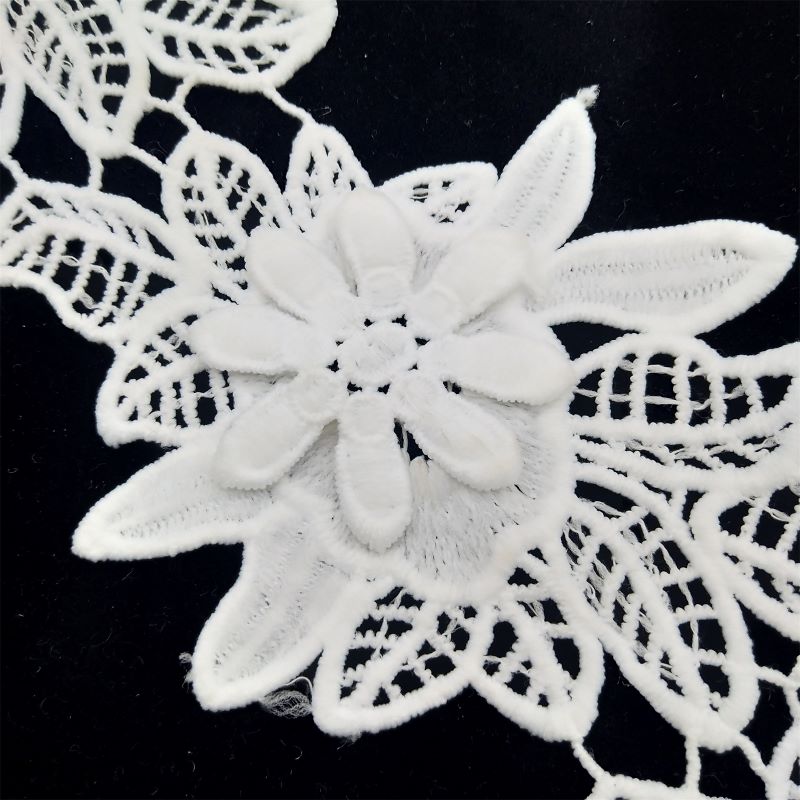The Intricate World of 3D Lace Fabric: Exploring Materials, Processes, and Costs
Introduction
Lace has a timeless allure that has captivated fashion enthusiasts and designers for centuries. Its delicate and intricate patterns add a touch of elegance and sophistication to a wide range of garments and accessories. Among the various types of lace, 3D lace fabric stands out as a particularly luxurious and exquisite choice. In this comprehensive article, we will delve deep into the world of 3D lace fabric, exploring the factors that contribute to its high cost and its journey from raw materials to the final product.
Section 1: Understanding 3D Lace Fabric
1.1 What is 3D Lace Fabric?
3D lace fabric is a type of lace that is known for its three-dimensional or raised patterns, which give it a unique texture and visual depth. Unlike traditional flat lace, 3D lace stands out due to its intricate, sculptural designs, which can include flowers, geometric shapes, or other motifs. This extraordinary fabric is widely used in high-end fashion, bridal wear, and couture due to its intricate beauty and exceptional quality.
Experience the allure of our assorted 3D lace fabrics designed for the most memorable weddings. This video presentation is your window to a world of exquisite lace, tailored to elevate your special day.
1.2 The Appeal of 3D Lace
3D lace fabric is prized for its luxurious appearance and texture. Its three-dimensional patterns create depth and intricacy that can make a garment or accessory truly special. The combination of delicacy and dimensionality makes 3D lace a favorite among designers who seek to create breathtaking and memorable pieces.
Indulge in the captivating world of 3D lace fabric! This modeling image showcases the intricate textures and elegant patterns, perfect for exquisite wedding gowns and luxurious attire. Elevate your style and embrace timeless beauty with our stunning lace.
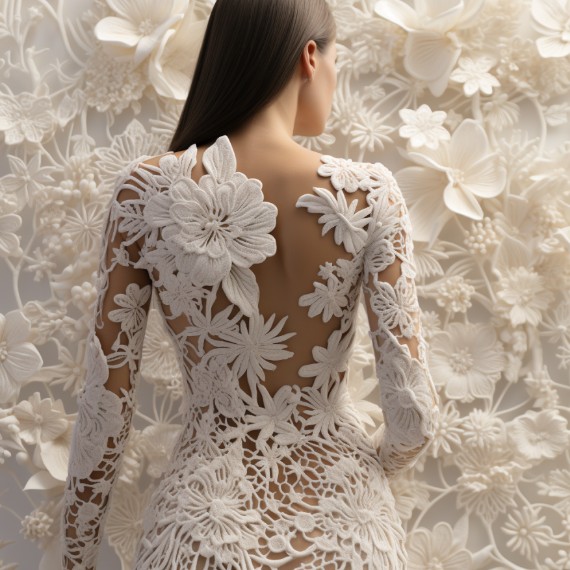
Section 2: The Material Behind the Magic
2.1 Lace Materials
Lace, including 3D lace, is typically made from a variety of materials, including:
2.1.1 Cotton: Cotton lace is known for its softness and breathability, making it comfortable to wear in warm weather. It is commonly used for more casual lace garments.
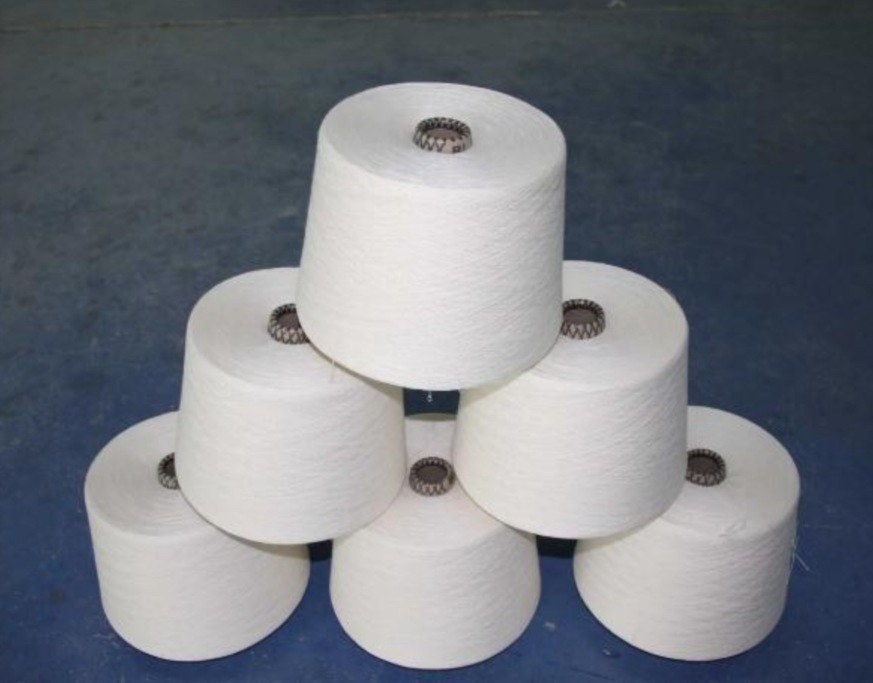
Explore the elegance of all-cotton threads in their natural white hue. These threads are ideal for your sewing needs, offering quality and purity in every stitch. Create with confidence using these versatile and dependable cotton threads.
2.1.2 Silk: Silk lace is considered the most luxurious and elegant option. Its natural sheen and drape make it perfect for formal occasions and high-end fashion.
Behold the timeless elegance of white silk, a fabric of unparalleled grace and luxury. Its lustrous sheen and soft texture make it a symbol of sophistication and refinement. Whether it’s a bridal gown or fine drapery, white silk epitomizes pure, timeless beauty.
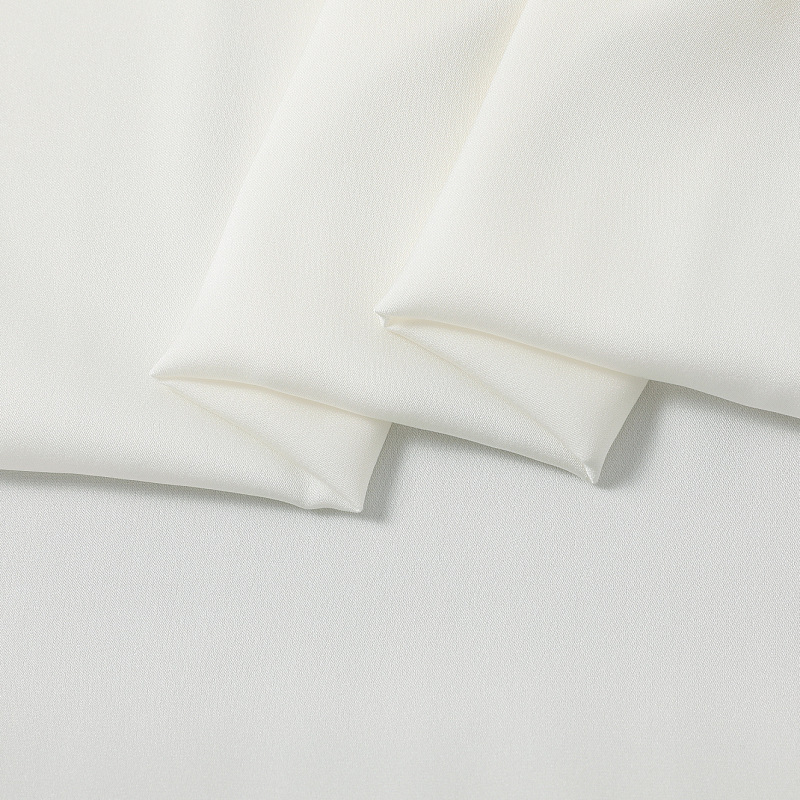
2.1.3 Synthetic fibers: Modern manufacturing techniques have enabled the creation of synthetic lace fabrics that mimic the appearance and feel of natural fibers while offering more affordability.
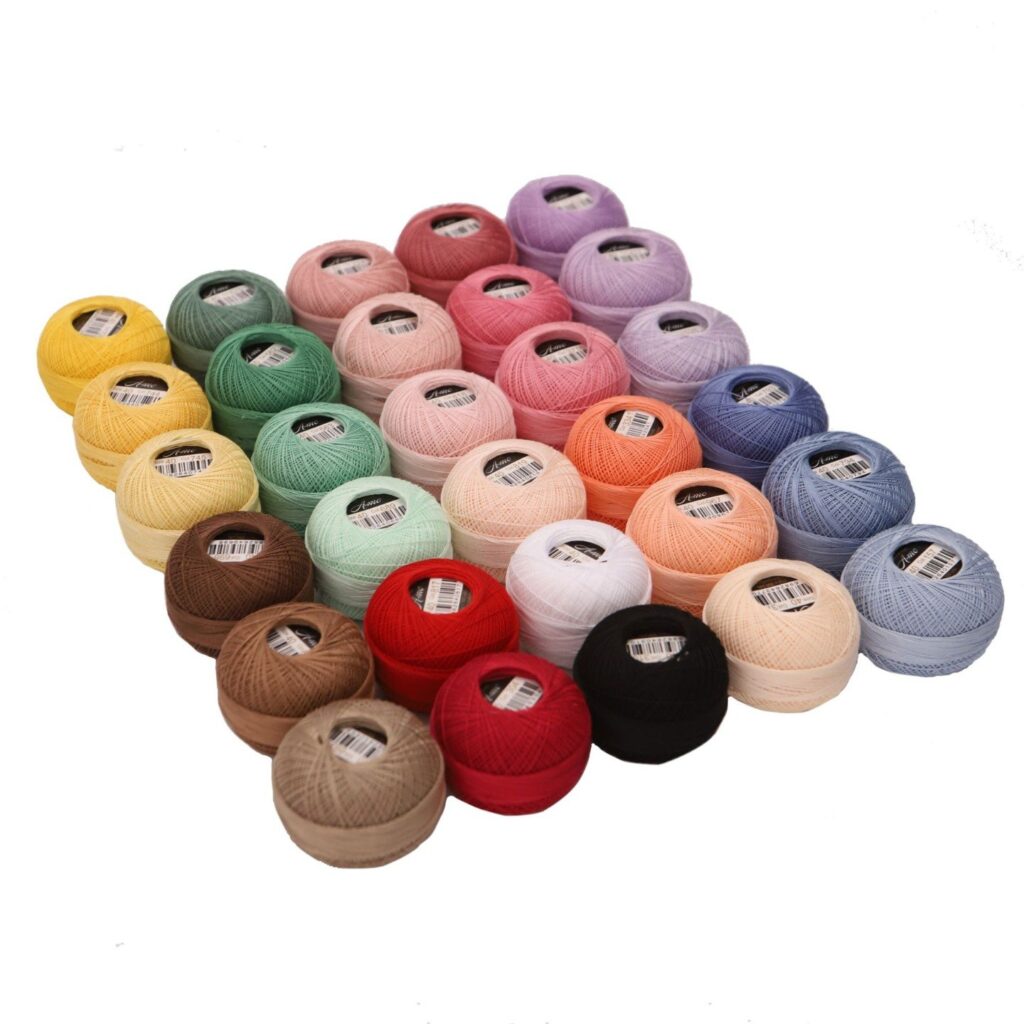
In this vibrant image, synthetic chemical fiber raw materials burst with a kaleidoscope of colors. These versatile, man-made fibers are the building blocks for a wide range of textiles, offering endless possibilities in fashion, industrial applications, and more. The vivid hues symbolize the innovation and creativity that these materials bring to countless products, from clothing to technical textiles.
2.2 Quality Matters
The quality of the materials used in 3D lace fabric plays a crucial role in determining its cost. High-quality 3D lace often features natural fibers like silk and fine cotton, contributing to a soft touch and an exquisite finish. These natural fibers are more expensive than synthetic alternatives, and their use adds to the overall cost of production.
Section 3: The Art of 3D Lace Production
3.1 Traditional vs. Modern Production
The creation of 3D lace fabric is an intricate process that demands skill and precision. There are two primary methods of producing 3D lace: traditional handmade techniques and modern machine-based processes.
3D lace fabric production, there will be several processes to produce out, this embroidery is only one of the processes, after embroidery, and then by machine or hand to the 3D flowers and then sewed up!
3.1.1 Traditional Handmade Techniques
Traditional lace-making techniques involve skilled artisans who handcraft each piece. This labor-intensive process often includes techniques like bobbin lace, needlepoint lace, and tatting. While these methods are time-consuming and require significant expertise, they result in the most exquisite and unique 3D lace designs.
3.1.2 Modern Machine-Based Processes
To meet the growing demand for 3D lace, modern manufacturing techniques have been developed. Computerized machines can replicate complex patterns, but the finished product lacks the handmade charm and individuality of traditional lace. This is a more cost-effective method of production and is often used for more affordable lace options.
3.2 The Role of Embroidery
One of the defining features of 3D lace is embroidery. This intricate, decorative technique involves adding patterns, motifs, and textures to the lace. The complexity and detail of the embroidery significantly impact the cost of 3D lace fabric. Highly detailed, multi-colored, and three-dimensional designs are more labor-intensive and require additional materials, contributing to higher costs.
Enhance your creations with our stunning 3D lace trim. Delicate and intricate, this trim features a captivating three-dimensional design that adds elegance and sophistication. Meticulously crafted, each stitch creates a mesmerizing effect, offering a dynamic texture. Whether on a dress, lingerie, or home decor, our 3D lace trim exudes a mesmerizing allure, elevating your designs with luxury and artistry.
3.3 Time and Skill
Handmade 3D lace production is not only time-consuming but also requires a high level of skill and attention to detail. Artisans may spend days or even weeks crafting a single yard of lace. Skilled labor is expensive, and the level of expertise involved in traditional lace-making adds to the overall cost.
Section 4: Dyeing and Finishing
4.1 Dyeing Techniques
Dyeing is a critical step in the production of 3D lace fabric, as it can transform the appearance of the lace. The choice of dyeing technique and the quality of dyes used affect the final product’s color vibrancy and longevity. Some common dyeing techniques for lace include piece dyeing, yarn dyeing, and garment dyeing, each with its associated costs.
4.2 Finishing Touches
The finishing of 3D lace fabric involves processes such as washing, steaming, and pressing to ensure its final appearance meets quality standards. The care and precision involved in these finishing touches contribute to the overall cost of production.
Section 5: High-End Production and Couture
5.1 Custom Designs
For couturiers and high-end fashion houses, custom 3D lace designs are not uncommon. Designers often commission unique lace patterns to create one-of-a-kind garments for their clients. These bespoke designs require additional time and resources, further increasing the cost of production.
5.2 Limited Editions
Some 3D lace fabrics are produced in limited quantities, which can drive up the price. The exclusivity of these lace pieces adds to their desirability, making them even more sought after by collectors and high-end fashion connoisseurs.
Section 6: The Role of Branding
6.1 Luxury Branding
Luxury fashion brands often use 3D lace in their collections to create signature pieces that showcase their craftsmanship and design expertise. The prestige associated with these brands and their commitment to quality can justify higher price points for their 3D lace garments.
6.2 Marketing and Brand Identity
Marketing and branding also play a significant role in the perceived value of 3D lace fabric. The way a brand presents its products, the image it conveys, and its reputation within the fashion industry can all influence the willingness of consumers to pay a premium for 3D lace items.
Section 7: Environmental and Ethical Considerations
7.1 Sustainability and Ethical Practices
In recent years, there has been a growing focus on sustainable and ethical fashion production. Brands that prioritize sustainable materials and ethical labor practices may incur additional costs, which can impact the final price of 3D lace fabric. Organic and eco-friendly materials, as well as fair labor practices, contribute to a higher price tag.
Indulge your senses with our mesmerizing multi-colored 3D lace fabric. Bursting with vibrant hues and intricate textures, this fabric is a true work of art. The three-dimensional design creates a captivating visual effect, adding depth and dimension to any garment or accessory. Its delicate craftsmanship and intricate patterns make it a standout choice for those seeking to create unique and unforgettable pieces. Whether for a stunning gown, statement lingerie, or stylish home decor, our multi-colored 3D lace fabric is the perfect choice to infuse your creations with a touch of enchantment and individuality.
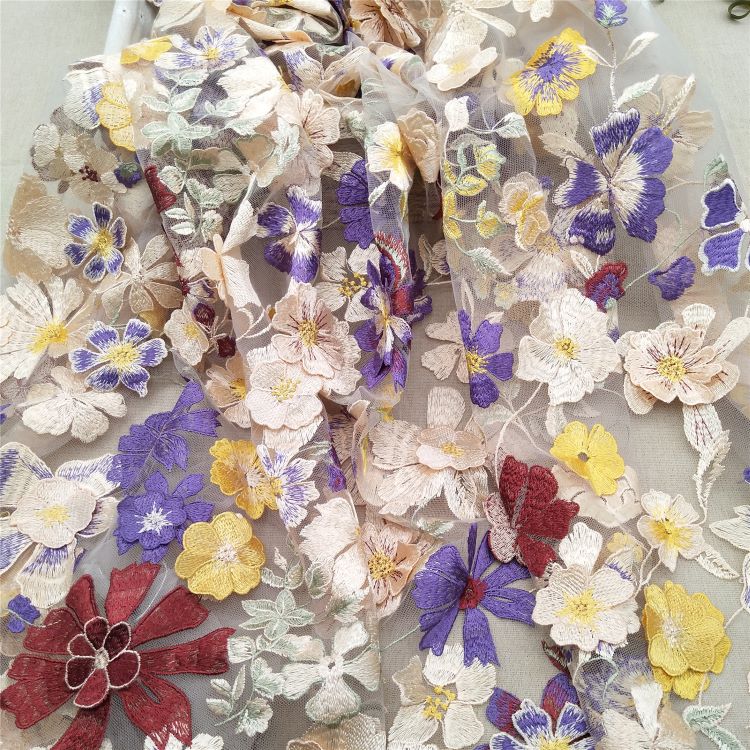
multicolor 3D LACE FABRIC
Section 8: The Economics of 3D Lace
8.1 Supply and Demand
The principles of supply and demand also come into play when determining the cost of 3D lace fabric. Limited availability, high demand from luxury and couture markets, and the labor-intensive nature of production all contribute to a premium price.
8.2 Global Production
The global nature of fashion production can lead to variations in 3D lace fabric costs. Lace can be made in various countries, each with its own cost structure. Factors such as labor costs, materials availability, and import/export tariffs can influence the final price of 3D lace.
Radiant and ethereal, our white 3D lace fabric for wedding gowns exudes timeless allure. The intricate three-dimensional design adds depth to every stitch, creating an enchanting visual effect. The pure white hue enhances the romantic allure, perfect for brides seeking a dreamy look. Meticulously crafted, this fabric transforms any gown into a masterpiece, embodying elegance and grace. Elevate your wedding ensemble with our white 3D lace fabric, and create everlasting memories.
Section 9: Factors Affecting the Cost of 3D Lace Fabric – A Summary
In summary, the high cost of 3D lace fabric can be attributed to a complex interplay of factors,Section 9: Factors Affecting the Cost of 3D Lace Fabrics
The cost of 3D lace fabrics can vary significantly depending on several factors. In this section, we will explore the key elements that influence the pricing of these exquisite textiles.
- Fabric Material:
- One of the most substantial factors affecting the cost of 3D lace fabrics is the type of material used. High-quality materials such as silk or pure cotton will often command a higher price than synthetic alternatives. Silk, in particular, is renowned for its luxurious feel and is a preferred choice for upscale designs.
- Production Method:
- The method used to create 3D lace fabrics also plays a crucial role in pricing. Handmade lace, with its intricate and labor-intensive craftsmanship, tends to be more expensive than machine-made lace. The precision and time invested in handcrafted lace contribute to its premium pricing.
- Complexity of Design:
- The complexity of the lace design significantly influences the cost. Intricate, highly detailed patterns with 3D elements require more time and skill to produce, which in turn affects the price. Simple geometric designs will be more affordable than ornate, floral patterns.
- Production Location:
- The location of lace production can impact the cost. Lace produced in countries with higher labor and production costs may be pricier than lace from regions with lower production expenses. Italian and French laces, for example, are known for their quality but can be more expensive.
- Dyeing and Coloring:
- The process of dyeing lace to achieve specific colors or shades adds to the cost. Natural and pastel colors are generally more expensive than white or off-white options, as achieving these shades requires additional resources and expertise.
- Lace Width and Length:
- The dimensions of the lace also affect the price. Wider or longer lace pieces will naturally cost more due to the increased material and production efforts required. This is particularly relevant when ordering lace for large garments or projects.
- Brand and Reputation:
- The reputation of the manufacturer or brand can significantly influence the price. Established brands with a history of producing high-quality lace may charge a premium for their products. Artisanal lace makers known for their craftsmanship often have a dedicated following willing to pay for their unique creations.
- Customization:
- Customized lace designs or color choices typically come at a higher cost. Customers who want a one-of-a-kind lace pattern or specific color may need to pay more for the design and production process tailored to their requirements.
- Sustainability and Eco-friendliness:
- As sustainability becomes a more significant concern in the textile industry, lace made from eco-friendly materials or using environmentally conscious production methods can cost more. These practices often entail higher expenses, reflecting a commitment to responsible manufacturing.
- Market Demand:
- Market demand can fluctuate, impacting lace prices. When certain lace styles or colors are in high demand, their cost may increase due to limited availability or the premium placed on fashionable designs.
- Historical Significance:
- Lace with historical or cultural significance may be priced higher due to its heritage. Antique lace, or lace designs with a rich historical background, can be considered collector’s items and carry a premium price tag.
- Packaging and Presentation:
- High-end packaging and presentation can also influence the overall cost of 3D lace fabrics. When lace is presented in an elegant, custom-designed box or packaging, it can add to the perceived value and cost.
In summary, the cost of 3D lace fabrics is determined by a combination of factors, including the material used, production method, complexity of design, production location, dyeing, lace dimensions, brand reputation, customization, sustainability practices, market demand, historical significance, and even the packaging. Understanding these factors can help consumers make informed decisions when selecting the perfect 3D lace for their project, whether it’s for a wedding gown, couture fashion, or interior décor. Ultimately, the price reflects the quality, craftsmanship, and unique attributes of each lace product, making it an investment in beauty and artistry.
FQAs:
- What are 3D lace fabrics?
- 3D lace fabrics are intricately designed textiles with three-dimensional patterns.
- How are 3D lace fabrics different from traditional lace?
- 3D lace has raised, textured designs, while traditional lace is typically flat.
- What makes 3D lace fabrics ideal for wedding gowns?
- Their intricate and elegant appearance adds a touch of luxury to bridal attire.
- Are 3D lace fabrics comfortable to wear?
- Yes, they are typically comfortable, as they are often made from soft, high-quality materials.
- What are some popular applications for 3D lace fabrics?
- Wedding dresses, evening gowns, and couture fashion often feature 3D lace.
- How can one care for 3D lace fabrics?
- Gentle hand-washing or dry cleaning is usually recommended to maintain their quality.
- What types of patterns are common in 3D lace fabrics?
- Floral, geometric, and abstract patterns are often seen in 3D lace designs.
- Are 3D lace fabrics suitable for DIY projects?
- Yes, they can be used for crafting and adding elegance to various DIY projects.
- What color options are available in 3D lace fabrics?
- A wide range of colors is available, but white and ivory are popular for weddings.
- Can 3D lace fabrics be used for interior décor?
- Yes, they can be used for curtains, table linens, and other decorative items.
- Are there different fabric blends used in 3D lace?
- Yes, lace can be made from various blends, including silk, cotton, and synthetic materials.
- What’s the historical significance of 3D lace fabrics?
- They have been used in fashion for centuries, often associated with elegance and opulence.
- How do 3D lace fabrics contribute to sustainable fashion?
- When made from eco-friendly materials, they can align with sustainable fashion practices.
- Can 3D lace fabrics be customized for unique designs?
- Yes, some manufacturers offer customization options for bespoke creations.
- Are 3D lace fabrics suitable for both modern and vintage styles?
- Yes, they are versatile and can complement a range of fashion aesthetics.
- How can one identify high-quality 3D lace fabrics?
- Look for fine craftsmanship, soft textures, and intricate patterns.
- What’s the best way to store 3D lace fabrics to prevent damage?
- Store them in a cool, dry place away from direct sunlight and humidity.
- Can 3D lace fabrics be used for everyday clothing, or are they primarily for special occasions?
- They are suitable for both special occasions and everyday wear, depending on the design.
- How has technology influenced the production of 3D lace fabrics?
- Advanced manufacturing techniques have made intricate 3D designs more accessible.
- Where can I find a wide selection of 3D lace fabrics?
- High-end fabric stores, specialty boutiques, and online fabric retailers offer diverse options.

